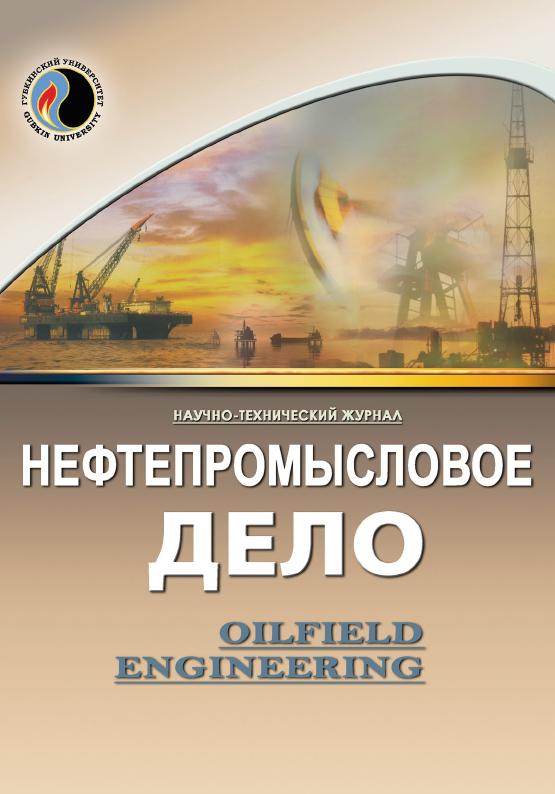The root cause of high back pressure on the plunger of an oil-well sucker-rod pump before opening the discharge valve
UDC: 622.276.53.054.22
DOI: 10.33285/0207-2351-2023-9(657)-52-57
Authors:
ISHMURZIN ABUBAKIR A. 1
1,
ISHMURZINA NAZYRA M. 2
2,
MUSTAFIN VALERY YU. 3
3
1 Ufa State Petroleum Technological University, Ufa, Russia
2 Ufa University of Science and Technologies, Ufa, Russia
3 Bashneft-Dobycha, Ufa, Russia
Keywords: bending of the strings column bottom part, differential pressure above and below the ball of the discharge valve, weighted bottom, dynamogram configuration, oil-well sucker-rod pump with a discharge valve at the top of the cylinder
Annotation:
The article considers the situation of bending of the bottom part of the sucker-rod strings, the consequences and ways to get rid of it. This bending creates a misalignment of the plunger, which in its turn, additionally provokes strings bending. It results in an interdependent effect occurrence when a higher pressure under the plunger is required to open the valve. However, these are only consequences, not the root cause. This physical phenomenon details were revealed in the course of the analytical study of the problem. It turns out that the areas on which this pressure acts from above and below the ball of the discharge valve are different. To equalize the force actions, additional pressure will be required on the valve ball from below, which is ensured by the plunger further movement down until the forces are equalized. For this reason, the opening of the valve is delayed and the bending of the string in its lower part receives additional motivation.
When calculating the length of the plunger stroke by a dynamometer chart it is generally accepted that the fluid pressure in the lifting column neutralizes the pressure under the plunger, and the weight of the rod string lower part compensates for all mechanical and hydrodynamic obstacles to the plunger downward stroke, and this equilibrium represents a critical moment to the opening of the discharge valve.
Marketing activities of the problem under consideration showed that the main reason for the high back pressure on the plunger before opening the discharge valve is a layout scheme of the oil-well sucker-rod pump. The use of a weighted bottom, unfortunately, does not completely eliminate this negative phenomenon. Exclusion of the bending of the lower part of the string of rods is possible in case when the discharge stroke will occur when the string of rods is stretched, but not compressed. To do this, it is necessary to change the layout of the oil-well sucker-rod pump, which can be realized by placing a discharge valve in the upper part of the cylinder, and the suction valve – to the plunger, in which the plunger stroke goes down without back pressure.
Bibliography:
1. Adonin A.N. Dobycha nefti shtangovymi nasosami. – M.: Nedra, 1979. – 213 s.
2. Ishmurzin A.A. Nekotorye voprosy gidravliki i rabotosposobnosti glubinnykh nasosov pri otkachke parafinistoy nefti: dis. … kand. tekhn. nauk: 05.315. – M.: MINKh i GP im. I.M. Gubkina, 1972.
3. Ishmurzin A.A., Sharipov R.S. Opredelenie koeffitsienta oblegcheniya vesa kolonny shtang v skvazhine metodom staticheskoy obrabotki dannykh dinamometrirovaniya // Povyshenie nadezhnosti oborudovaniya dlya bureniya i ekspluatatsii neftyanykh i gazovykh skvazhin: Mezhvuzovskiy nauch.-temat. sb. – Ufa: UNI, 1980. – S. 122–127.
4. Ishmurzin A.A., Galimov A.M., Mustafin V.Yu. Rezul’taty promyslovykh ispytaniy skvazhinnogo shtangovogo nasosa s dopolnitel’nym klapanom v verkhney chasti tsilindra // Neft’, gaz i biznes. – 2014. – № 7. – S. 29–33.
5. Ishmurzin A.A., Mustafin V.Yu., Ishmurzina N.M. Matematicheskaya model’ skvazhinnogo shtangovogo nasosa s otsekayushchim klapanom v verkhney chasti tsilindra // Neftepromyslovoe delo. – 2019. – № 3. – S. 40–44. – DOI: 10.30713/0207-2351-2019-40-44
6. Pat. na polez. model’ 165002, F04B 53/10, F04B 47/02. Nagnetatel’nyy klapannyy uzel skvazhinnogo shtangovogo nasosa / A.A. Ishmurzin, V. Yu. Mustafin, N.M. Ishmurzina. – № 2015133762/06; zayavl. 11.08.2015; opubl.27.09.2016, Byul. № 27.
7. Ishmurzin A.A. K vyboru gruppy posadki plunzhera v tsilindre shtangovogo skvazhinnogo nasosa // Neftegazovoe delo. – 2004. – № 2. – S. 103–118.
8. Ishmurzin A.A., Ishmurzina N.M., Mustafin V.Yu. Neraskrytye svoystva inertsionnykh sil kolonny nasosnykh shtang v dinamogrammakh skvazhinnykh shtangovykh nasosnykh ustanovok // Neftepromyslovoe delo. – 2023. – № 2(650). – S. 29–34. – DOI: 10.33285/0207-2351-2023-2(650)-29-34
9. Shchurov I.V. Povyshenie effektivnosti ekspluatatsii skvazhin za schet optimizatsii kinematicheskikh kharakteristik shtangovykh nasosov: dis. … cand. techn. nauk: 25.00.17. – Samara: Samarskiy politekhnicheskiy un-t, 2002.

